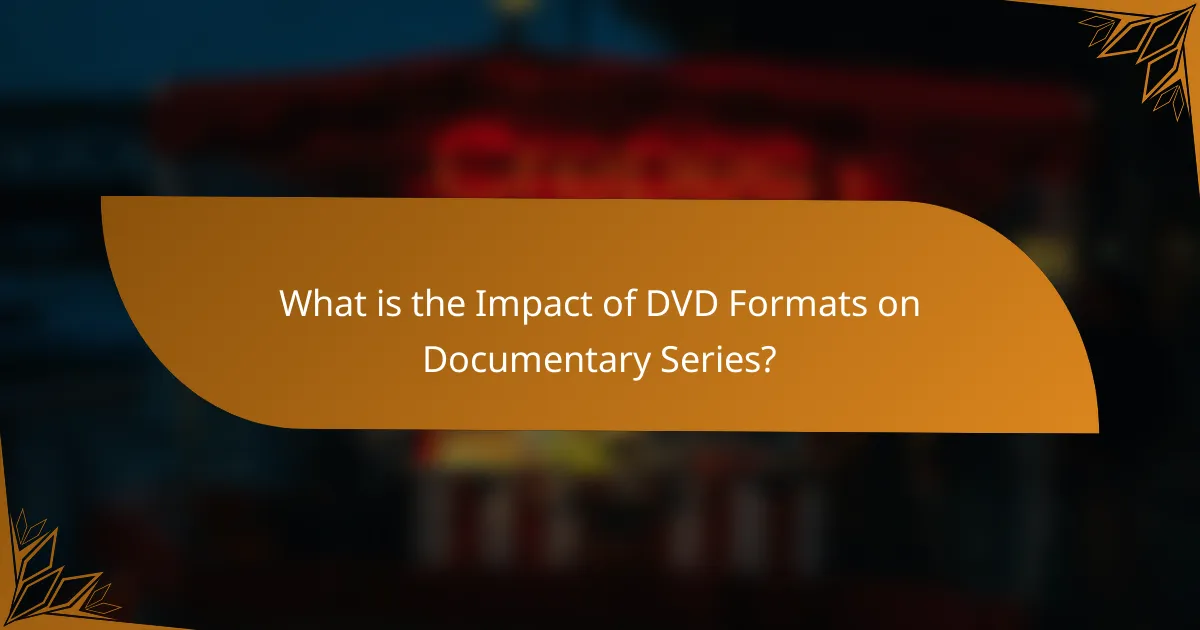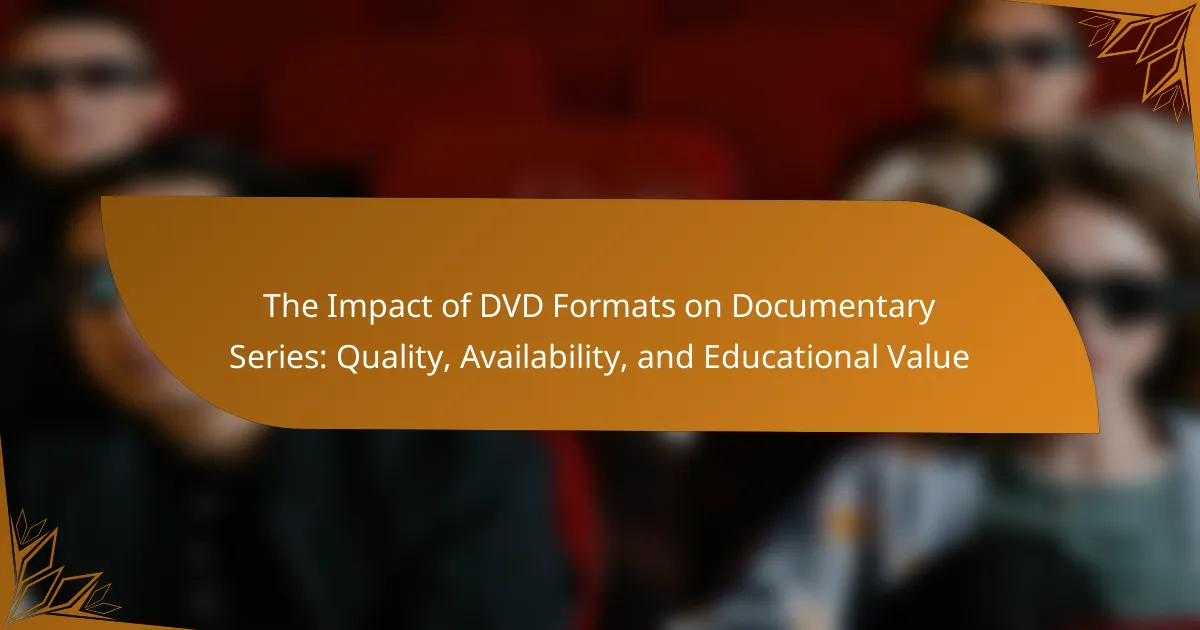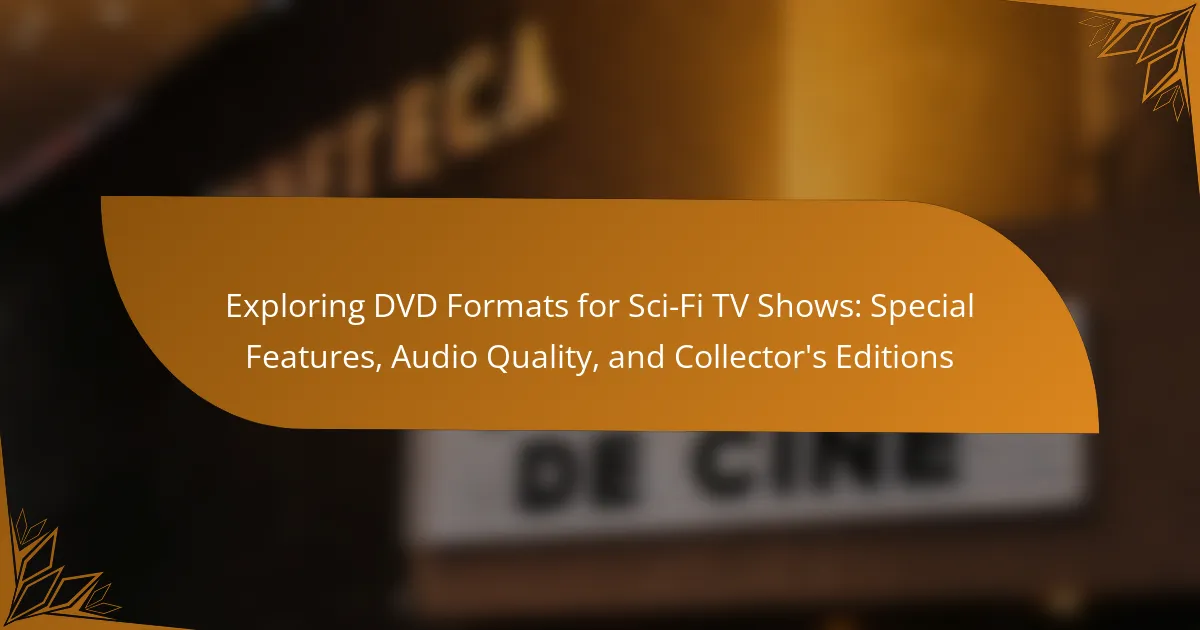DVD formats play a crucial role in shaping the quality, accessibility, and educational value of documentary series. The compression techniques inherent in these formats directly influence both video and audio quality, with higher quality options like DVD-Audio enhancing the overall viewing experience. Accessibility is improved through broader distribution channels, making documentaries more available in retail and online markets. Educational institutions frequently utilize DVDs for teaching, benefiting from supplementary materials such as interviews and behind-the-scenes footage. Research highlights that DVD formats can significantly affect viewer engagement and information retention, further emphasizing their importance in educational contexts. Additionally, interactive features like chapter selections enhance the learning experience, making DVDs a valuable resource for both educators and learners.

What is the Impact of DVD Formats on Documentary Series?
DVD formats significantly impact documentary series by influencing their quality, accessibility, and educational value. The compression techniques used in DVD formats affect video and audio quality. Higher quality formats, such as DVD-Audio, provide superior sound, enhancing the viewing experience. Accessibility is also shaped by DVD formats; they allow for broader distribution and availability in retail and online markets. Many educational institutions utilize DVDs for teaching purposes, as they can include supplementary materials like interviews and behind-the-scenes footage. Research indicates that the format can impact viewer engagement and retention of information, making it a valuable tool in educational settings. Furthermore, the interactive features of DVD formats, such as chapter selections and additional content, enhance the learning experience.
How do different DVD formats influence the quality of documentary series?
Different DVD formats significantly influence the quality of documentary series. Standard DVD formats typically provide lower resolution and audio quality compared to Blu-ray formats. Blu-ray discs support high-definition video, offering resolutions up to 1080p. This enhanced resolution allows for clearer visuals and more detailed imagery in documentaries. Additionally, Blu-ray supports advanced audio formats, delivering superior sound quality.
The compression methods used in different formats also affect quality. Standard DVDs often use MPEG-2 compression, which can degrade visual fidelity. In contrast, Blu-ray employs more efficient codecs like AVC, resulting in better image retention.
Research indicates that viewers perceive a noticeable difference in quality between standard DVDs and Blu-ray. A study by the Consumer Electronics Association found that 70% of viewers preferred the Blu-ray format for its superior image and sound quality. This preference is particularly important for educational documentaries, where clarity can enhance understanding and engagement.
What are the key differences between DVD formats regarding video and audio quality?
The key differences between DVD formats regarding video and audio quality include resolution, compression methods, and audio encoding. Standard DVDs typically offer a maximum resolution of 720×480 pixels. In contrast, DVD formats like DVD-Video can support higher quality through better compression techniques.
DVD-Audio provides higher fidelity audio, supporting lossless formats and multi-channel sound. Additionally, some formats allow for higher bit rates, enhancing the overall audio experience.
For example, DVD-Audio can deliver up to 192 kHz sample rates compared to the 48 kHz standard for DVD-Video. These variations result in noticeable differences in viewing and listening experiences across DVD formats.
How do compression techniques in DVD formats affect documentary content?
Compression techniques in DVD formats significantly impact documentary content by reducing file size while attempting to maintain quality. These techniques, such as MPEG-2 encoding, lower the bit rate and remove redundant data. As a result, some visual and audio quality may be compromised. This can lead to artifacts like pixelation or audio distortion, which detract from the viewing experience. Furthermore, compression can limit the amount of supplementary content, such as interviews or behind-the-scenes footage, that can be included. Studies show that excessive compression can alter the clarity of critical information presented in documentaries. Therefore, while compression enables broader distribution, it can negatively affect the educational value and overall quality of documentary content.
In what ways do DVD formats affect the availability of documentary series?
DVD formats affect the availability of documentary series by determining distribution methods and compatibility with playback devices. Different DVD formats, such as DVD-Video and DVD-R, influence how series are marketed and sold. For instance, DVD-Video is widely compatible with most players, increasing accessibility. In contrast, formats like DVD-R may have limited compatibility, reducing potential audience reach. Additionally, region coding on DVDs can restrict access to certain series in specific geographical areas. The choice of format can also impact storage capacity, affecting the number of episodes included in a series. Ultimately, these factors lead to variations in the availability of documentary series across different markets and platforms.
What are the most common DVD formats used for distributing documentaries?
The most common DVD formats used for distributing documentaries are DVD-Video and DVD-ROM. DVD-Video is the standard format for video playback on DVD players. It supports various video and audio codecs, ensuring high-quality viewing experiences. DVD-ROM is used primarily for data storage and can include multimedia content, such as interactive features and additional resources. These formats are widely recognized for their compatibility with consumer electronics. According to the DVD Forum, over 1.5 billion DVDs were sold globally in 2020, highlighting their popularity in documentary distribution.
How do regional DVD format variations impact accessibility for viewers?
Regional DVD format variations restrict accessibility for viewers. Different regions use distinct formats, such as NTSC and PAL. These formats affect playback compatibility with DVD players. For instance, NTSC is common in North America, while PAL is prevalent in Europe. Viewers may encounter issues when trying to play DVDs from different regions. Many DVD players are region-locked, limiting playback to specific geographical areas. This restriction can hinder access to documentary series that are only available in certain formats. Consequently, viewers may miss out on educational content due to these regional limitations.
Why is educational value a significant aspect of documentary series on DVD?
Educational value is significant in documentary series on DVD because it enhances learning opportunities for viewers. Documentaries often present factual information, historical context, and expert insights. This format allows for in-depth exploration of subjects that may not be covered in traditional educational settings. DVDs provide the advantage of repeat viewing, enabling audiences to absorb complex topics thoroughly. The inclusion of supplementary materials, such as interviews and behind-the-scenes footage, further enriches understanding. Research has shown that visual learning aids retention and comprehension, making documentaries effective educational tools. According to a study published in the Journal of Educational Psychology, visual media can improve learning outcomes by up to 50%. Thus, the educational value of documentary series on DVD plays a crucial role in their impact on viewers.
How do DVD formats enhance or limit educational features in documentary series?
DVD formats enhance educational features in documentary series by providing interactive content and multiple viewing options. They often include features like subtitles, chapter selections, and bonus materials. These features allow viewers to engage more deeply with the content. For example, subtitles can aid comprehension for non-native speakers. Additionally, chapter selections enable targeted learning by allowing viewers to skip to relevant sections.
However, DVD formats can also limit educational features. The physical medium restricts accessibility compared to streaming options. Not all viewers may have DVD players, limiting the audience. Furthermore, the storage capacity of DVDs can restrict the amount of content included. This can lead to omissions of valuable supplementary materials. Overall, while DVD formats offer certain educational enhancements, they also present significant limitations in accessibility and content breadth.
What role do supplemental materials play in the educational value of DVD documentaries?
Supplemental materials enhance the educational value of DVD documentaries by providing additional context and resources. These materials often include behind-the-scenes footage, interviews with experts, and study guides. Such content deepens the viewer’s understanding of the documentary’s subject matter. Research indicates that students retain information better when they engage with supplementary resources. For example, a study by the University of California found that students using supplemental materials scored 20% higher on retention tests. This evidence supports the idea that supplemental materials are crucial for maximizing educational outcomes in DVD documentaries.
How do DVD formats relate to viewer engagement with documentary series?
DVD formats enhance viewer engagement with documentary series by providing accessible content and interactive features. They allow viewers to watch at their convenience, which increases the likelihood of viewing multiple episodes. DVD formats often include bonus materials, such as interviews and behind-the-scenes footage, enriching the viewing experience. This additional content fosters a deeper understanding of the subject matter. Research indicates that viewers are more likely to engage with content that offers interactive elements. A study by the University of Southern California found that supplemental materials significantly boost viewer retention and interest. Therefore, DVD formats play a crucial role in enhancing viewer engagement with documentary series.
What challenges do documentary creators face with different DVD formats?
Documentary creators face several challenges with different DVD formats. Compatibility issues arise when formats do not play on all DVD players. Quality can vary significantly between formats, affecting the viewer’s experience. Storage capacity limits impact the amount of content that can be included. Different formats may require specific encoding, complicating the production process. Distribution can also be hindered by format variations, leading to increased costs. Additionally, some formats may not support interactive features, limiting educational value. These challenges necessitate careful planning and consideration in the production and distribution of documentary content.
What are the best practices for choosing DVD formats for documentary series?
Choose DVD formats that maximize quality and compatibility for documentary series. Select formats like DVD-Video for broad compatibility with standard players. Consider using DVD-R or DVD+R for single-use recordings. Opt for dual-layer DVDs to increase storage capacity, allowing for higher quality video and additional content. Ensure the chosen format supports the intended resolution, such as 480p for standard definition or 1080p for high definition. Investigate the target audience’s playback capabilities to avoid format issues. Research shows that using widely accepted formats enhances accessibility, increasing viewership and educational impact.
How can creators ensure optimal quality and accessibility in DVD distribution?
Creators can ensure optimal quality and accessibility in DVD distribution by utilizing high-definition video formats and incorporating multiple audio options. High-definition formats like Blu-ray offer superior image clarity compared to standard DVDs. Multiple audio tracks, including subtitles and closed captions, enhance accessibility for diverse audiences.
Additionally, creators should consider the use of region-free discs to reach a broader audience. Implementing user-friendly menus can improve navigation for viewers. Testing the final product on various devices ensures compatibility and quality across platforms.
Research indicates that DVDs with enhanced accessibility features significantly increase viewer engagement and satisfaction. For example, studies show that including subtitles can improve comprehension by up to 80% for non-native speakers. This approach not only meets legal accessibility standards but also enriches the educational value of documentary series.
What tips can enhance the educational value of DVD documentary series?
To enhance the educational value of DVD documentary series, include supplementary materials. These materials can be study guides, quizzes, or discussion questions. Incorporating expert interviews adds depth and perspective. Providing access to additional resources, such as articles or books, enriches the viewer’s understanding. Utilize clear and organized chapter divisions for easier navigation. Highlight key concepts and themes during the documentary to reinforce learning. Engage viewers with interactive elements, like viewer polls or forums. Finally, ensure high-quality visuals and audio to maintain viewer interest and focus.
The primary entity of this article is DVD formats and their impact on documentary series. The article examines how different DVD formats influence video and audio quality, accessibility, and the educational value of documentaries. It highlights key differences in resolution and compression methods, discusses the role of supplemental materials in enhancing viewer engagement, and addresses challenges faced by creators in choosing formats. Furthermore, it emphasizes best practices for optimizing quality and accessibility in DVD distribution to maximize the educational outcomes of documentary series.



